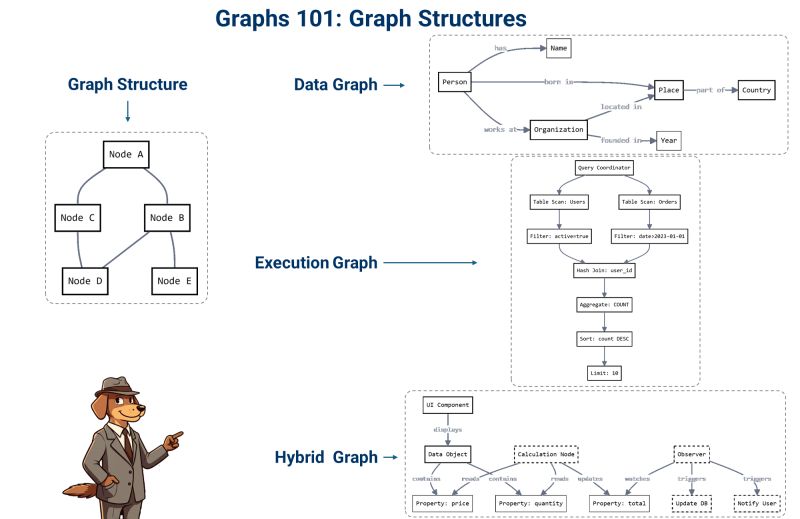Graphs are everywhere—whether powering search engines, optimizing logistics, or driving AI decision-making. Yet, despite their widespread use, the term "graph" is often used interchangeably across domains, leading to confusion.
To cut through the noise, let’s break down the three core types of graph structures, their unique properties, and how they serve different purposes in data and computational ecosystems.
This Graphs 101 series is about creating a shared language around graph technology, so whether you’re working with ontologies, execution pipelines, or hybrid AI systems, we’re all on the same page.
What is a Graph?
At its simplest, a graph is a collection of nodes (vertices) connected by edges (relationships).
But the true power of graphs isn’t just in storing relationships—it’s in how they enable dynamic queries, decision-making, and execution.
Unlike relational databases, which operate using tabular relationships, graphs rely on Graph Theory for querying and traversal, making them a natural fit for complex, interconnected data.
To make sense of how graphs are used in different contexts, we break them down into three main categories:
1️⃣ Data-Only Graphs (Static Relationships & Knowledge Representation)
These graphs model relationships between data entities without embedding execution logic. They are ideal for knowledge representation, classification, and semantic reasoning.
🔹 Examples:
- Ontologies – Formal knowledge structures (e.g., OWL ontologies in semantic web applications).
- Knowledge Graphs – Relationship-based networks (like Google’s Knowledge Graph).
- Citation Networks – Connecting academic papers via references.
- Road Networks – Modeling intersections as nodes and roads as edges.
Strengths:
✔️ Excellent for semantic reasoning and contextual relationships.
✔️ Ideal for search, discovery, and classification tasks.
✔️ Useful for industries like legal, research, and knowledge management.
Limitations:
❌ Static—these graphs don’t execute workflows or trigger actions.
❌ Often require complex ontologies to infer meaning.
2️⃣ Execution Graphs (Workflow & Computation Models)
Unlike data-only graphs, execution graphs model computational workflows. Nodes represent tasks or functions, and edges define the order of execution.
🔹 Examples:
- Database Query Execution Plans – How queries are optimized and processed.
- Compiler Abstract Syntax Trees – Transforming source code into execution steps.
- Deep Learning Computation Graphs – Optimized neural network processing.
- ETL Pipelines – Extract, transform, and load workflows for data movement.
Strengths:
✔️ Optimized for workflow automation and computation.
✔️ Perfect for AI/ML, data processing, and automation systems.
✔️ Provides a clear, traceable execution path.
Limitations:
❌ Focused purely on computation—doesn’t naturally capture semantic meaning.
❌ Not optimized for ad-hoc querying and discovery.
3️⃣ Hybrid Graphs (The Best of Both Worlds: Data + Execution)
Hybrid graphs combine data and execution nodes, enabling both relationship modeling and workflow execution.
This is where Data Object Graphs (DOGs) come in—a new approach that integrates both static knowledge and dynamic execution in one model.
🔹 Examples:
- Object Graphs – Data models in object-oriented systems, where entities have both state (data) and behavior (methods).
- Reactive Data Flows – Systems where changes propagate dynamically (e.g., Excel formulas).
- Data Object Graphs (DOGs) – Combining queryable data nodes and execution nodes (e.g., AI models, metrics, functions).
- Actor Systems – Distributed event-driven architectures where agents communicate via messages.
Strengths:
✔️ AI-ready: Enables dynamic decision-making by combining knowledge and execution.
✔️ Highly flexible: Supports real-time business processes and adaptive automation.
✔️ Ideal for AI-driven ecosystems, including AI Digital Twins and autonomous agents.
Limitations:
❌ More complex to design compared to static or execution-only graphs.
❌ Requires specialized infrastructure to handle hybrid processing models.
Why This Matters: A Unified Approach to Graph-Based Thinking
Traditional graph models tend to focus either on relationships (knowledge) or execution (computational workflows)—but businesses increasingly need both.
Understanding the distinction between data-only, execution, and hybrid graphs clarifies how to approach graph-based solutions for AI, automation, and analytics.
For example:
- A knowledge graph can tell you which customers are similar.
- An execution graph can process their transactions.
- A hybrid Data Object Graph (DOG) can do both—while also triggering AI models to predict future interactions.

What’s Next?
This Graphs 101 series will go deeper into each type, starting with data-only graphs—how they power ontologies, semantic reasoning, and next-gen search.
Stay tuned for the next post, where we explore how ontologies enable powerful knowledge representation and where they intersect with execution-based AI.
With Dataception Ltd’s Data Object Graphs, AI is just a walk in the park. 🐕🚀

